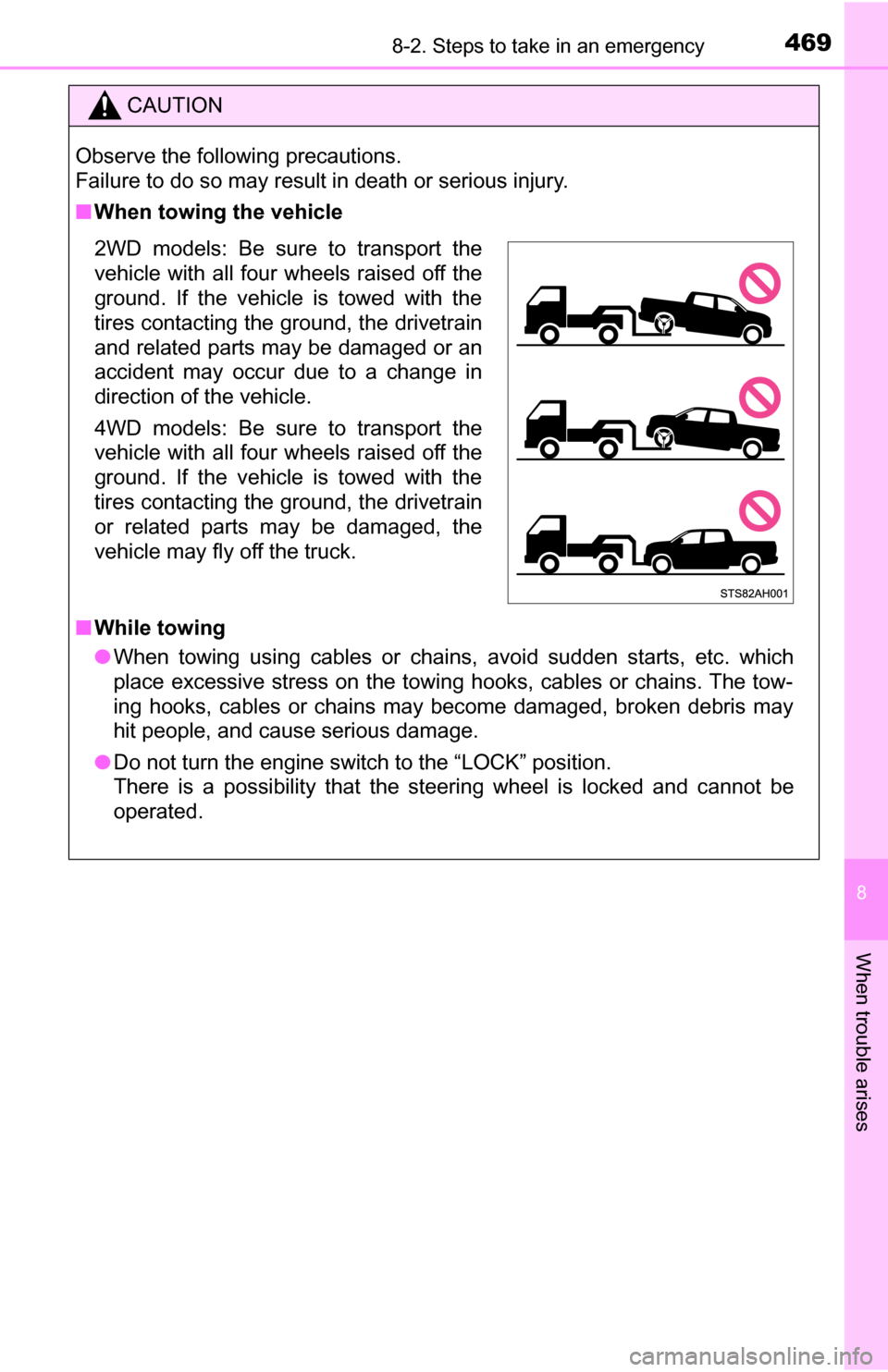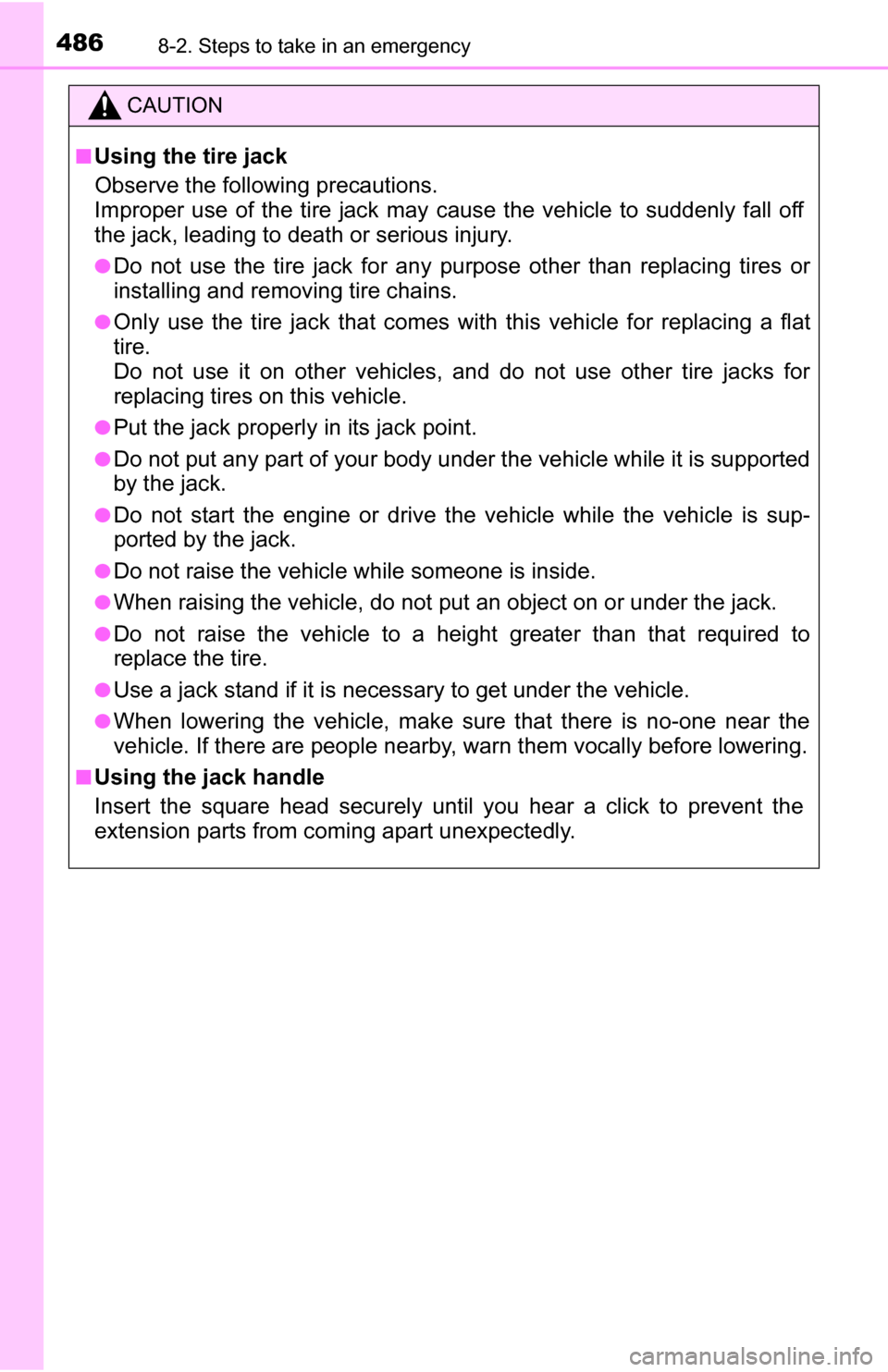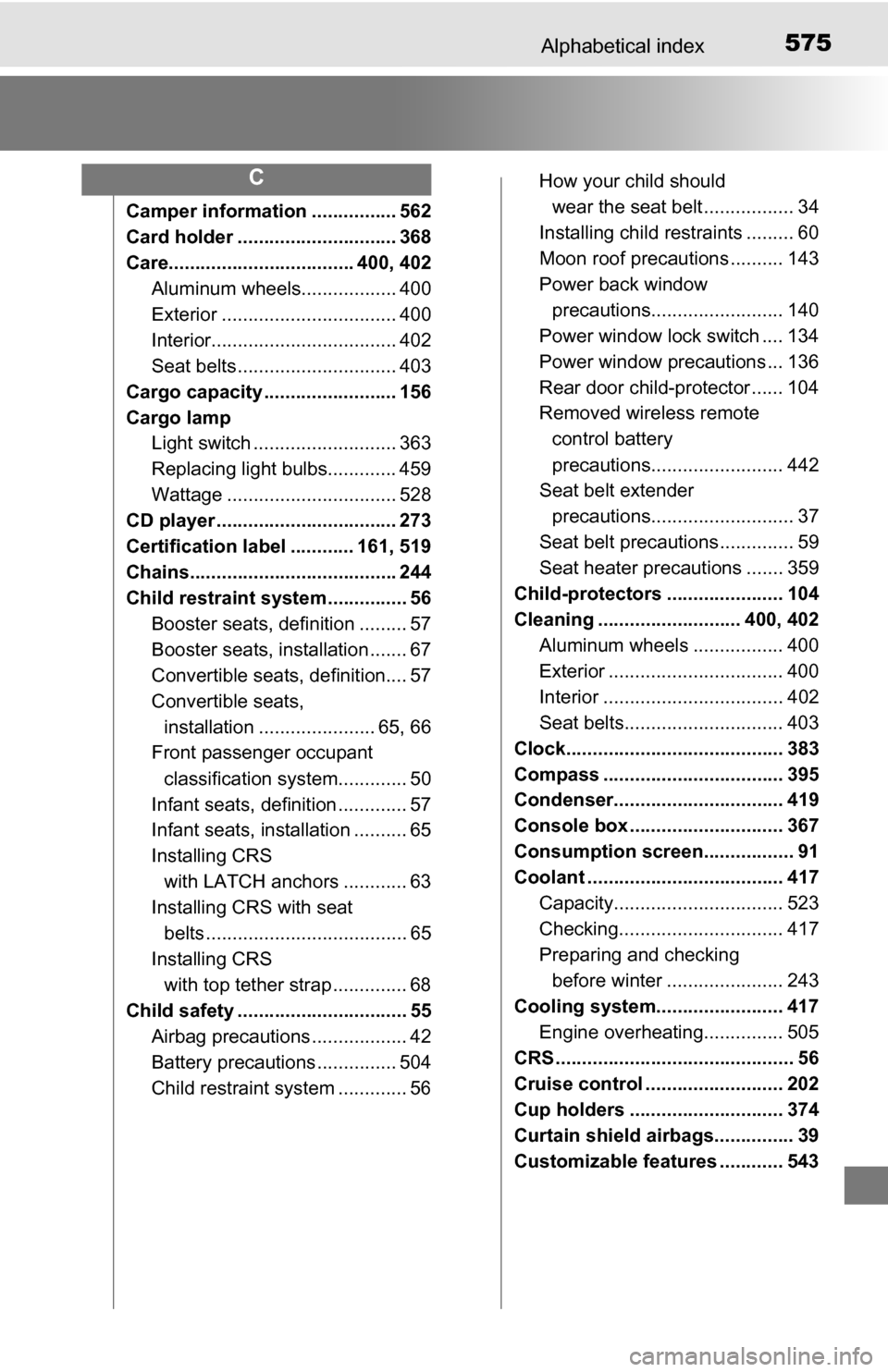Page 467 of 588
4678-2. Steps to take in an emergency
8
When trouble arises
From the front
Use a towing dolly under the rear
wheels.
From the rear
Use a towing dolly under the front
wheels.
If your vehicle is transported by a
flatbed truck, it should be tied
down at the locations shown in the
illustration.
If you use chains or cables to tie
down your vehicle, the angles
shaded in black must be 45 .
Do not overly tighten the tie
downs or the vehicle may be dam-
aged.
Towing with a wheel-lift type truck
Using a flatbed truck
Front
Page 468 of 588
4688-2. Steps to take in an emergency
If a tow truck is not available in an emergency, your vehicle may be
temporarily towed using cables or chains secured to the emergency
towing hooks. This should only be attempted on hard surfaced roads
for at most 50 miles (80 km) at 18 mph (30km/h).
A driver must be in the vehicle to steer and operate the brakes. The
vehicle’s wheels, drive train, axles, steering and brakes must be in
good condition.
Securely attach cables or chains to the towing hooks.
Take care not to damage the vehicle body.
Enter the vehicle being towed and start the engine.
If the engine does not start, turn the engine switch to the “ON” position.
4WD models: Put the front-wheel drive control switch in “2WD”.
Shift the shift lever to N and release the parking brake.
When the shift lever cannot be shifted: (P. 500)
Emergency towing
Emergency towing procedure
1
Ty p e AType B
2
3
4
Page 469 of 588

4698-2. Steps to take in an emergency
8
When trouble arises
CAUTION
Observe the following precautions.
Failure to do so may result in death or serious injury.
■When towing the vehicle
2WD models: Be sure to transport the
vehicle with all four wheels raised off the
ground. If the vehicle is towed with the
tires contacting the ground, the drivetrain
and related parts may be damaged or an
accident may occur due to a change in
direction of the vehicle.
4WD models: Be sure to transport the
vehicle with all four wheels raised off the
ground. If the vehicle is towed with the
tires contacting the ground, the drivetrain
or related parts may be damaged, the
vehicle may fly off the truck.
■While towing
● When towing using cables or chains, avoid sudden starts, etc. which
place excessive stress on the towing hooks, cables or chains. The tow-
ing hooks, cables or chains may become damaged, broken debris may
hit people, and cause serious damage.
● Do not turn the engine switch to the “LOCK” position.
There is a possibility that the steering wheel is locked and cannot be
operated.
Page 470 of 588
4708-2. Steps to take in an emergency
NOTICE
■To prevent damage to the vehicle wh en towing using a wheel-lift type
truck
● Do not tow the vehicle from the rear when the engine switch is in the
“LOCK” position or the key is removed.
The steering lock mechanism is not strong enough to hold the front wheels
straight.
● When raising the vehicle, ensure adequate ground clearance for towing at
the opposite end of the raised vehicle. Without adequate clearance, the
vehicle could be damaged while being towed.
■ To prevent damage to the vehicle when towing with a sling-type truck
Do not tow with a sling-type truck, either from the front or rear.
■ To prevent damage to the vehic le during emergency towing
Do not secure cables or chains to the suspension components.
Page 486 of 588

4868-2. Steps to take in an emergency
CAUTION
■Using the tire jack
Observe the following precautions.
Improper use of the tire jack may cause the vehicle to suddenly fall off
the jack, leading to death or serious injury.
●Do not use the tire jack for any purpose other than replacing tires or
installing and removing tire chains.
●Only use the tire jack that comes with this vehicle for replacing a flat
tire.
Do not use it on other vehicles, and do not use other tire jacks for
replacing tires on this vehicle.
●Put the jack properly in its jack point.
●Do not put any part of your body under the vehicle while it is supported
by the jack.
●Do not start the engine or drive the vehicle while the vehicle is sup-
ported by the jack.
●Do not raise the vehicle while someone is inside.
●When raising the vehicle, do not put an object on or under the jack.
●Do not raise the vehicle to a height greater than that required to
replace the tire.
●Use a jack stand if it is necessary to get under the vehicle.
●When lowering the vehicle, make sure that there is no-one near the
vehicle. If there are people nearby, warn them vocally before lowering.
■Using the jack handle
Insert the square head securely until you hear a click to prevent the
extension parts from coming apart unexpectedly.
Page 496 of 588

4968-2. Steps to take in an emergency
Confirm it is not loose after
tightening:Push and pull the tire
Try rotating
Visually check to ensure tire is
not hung on surrounding parts.
If looseness or misassembly exists, repeat step and step .
Repeat step , any time the ti re is lowered or disturbed.
Stow the tools and jack securely.
■The temporary spare tire
●The temporary spare tire is identified by the label “TEMPORARY USE
ONLY” on the disc wheel.
Use the temporary spare tire temporarily, and only in an emergency.
●Make sure to check the tire inflation pressure of the temporary spare
tire. ( P. 526)
■After completing the tire change
The tire pressure warning system must be reset. ( P. 426)
■When reinstalling the wheel ornament (on some models)
P. 4 3 6
■When using the temporary spare tire
As the temporary spare tire is not equipped with the tire pressure warning
valve and transmitter, low inflation pressure of the spare tire will not be
indicated by the tire pressure warning system. Also, if you replace the
temporary spare tire after the tire pressure warning light comes on, the
light remains on.
■If you have a flat rear tire on a road covered with snow or ice
Install the temporary spare tire on one of the front wheels of the vehicle.
Perform the following steps and fit tire chains to the rear tires:
Replace a front tire with the temporary spare tire.
Replace the flat rear tire with the tire removed from the front of the
vehicle.
Fit tire chains to the rear tires.
3
1
2
23
43
5
1
2
3
Page 498 of 588

4988-2. Steps to take in an emergency
NOTICE
■Do not drive the vehicle with a flat tire
Do not continue driving with a flat tire.
Driving even a short distance with a flat tire can damage the tire and the
wheel beyond repair.
■Driving with tire chains and the temporary spare tire
Do not fit tire chains to the temporary spare tire.
Tire chains may damage the vehicle body and adversely affect driving
performance.
■When replacing the tires
When removing or fitting the wheels, tires or the tire pressure warning
valve and transmitter, contact your Toyota dealer as the tire pressure
warning valve and transmitter may be damaged if not handled correctly.
■To avoid damage to the tire pressure warning valves and transmit-
ters
When a tire is repaired with liquid sealants, the tire pressure warning
valve and transmitter may not operate properly. If a liquid sealant is
used, contact your Toyota dealer or other qualified service shop as soon
as possible. Make sure to replace the tire pressure warning valve and
transmitter when replacing the tire. ( P. 425)
Page 575 of 588

575Alphabetical index
Camper information ................ 562
Card holder .............................. 368
Care................................... 400, 402Aluminum wheels.................. 400
Exterior ................................. 400
Interior................................... 402
Seat belts .............................. 403
Cargo capacity ......................... 156
Cargo lamp Light switch ........................... 363
Replacing light bulbs............. 459
Wattage ................................ 528
CD player .................................. 273
Certification label ............ 161, 519
Chains....................................... 244
Child restraint system ............... 56
Booster seats, definition ......... 57
Booster seats, installation ....... 67
Convertible seats, definition.... 57
Convertible seats, installation ...................... 65, 66
Front passenger occupant
classification syst em............. 50
Infant seats, definition ............. 57
Infant seats, installation .......... 65
Installing CRS with LATCH anchors ............ 63
Installing CRS with seat
belts ...................................... 65
Installing CRS with top tether strap .............. 68
Child safety ................................ 55 Airbag precautions .................. 42
Battery precautions ............... 504
Child restraint system ............. 56 How your child should
wear the seat belt ................. 34
Installing child restraints ......... 60
Moon roof precautions .......... 143
Power back window
precautions......................... 140
Power window lock switch .... 134
Power window precautions ... 136
Rear door child-protector ...... 104
Removed wireless remote
control battery
precautions......................... 442
Seat belt extender
precautions........................... 37
Seat belt precautions .............. 59
Seat heater precautions ....... 359
Child-protectors ...................... 104
Cleaning ........................... 400, 402 Aluminum wheels ................. 400
Exterior ................................. 400
Interior .................................. 402
Seat belts.............................. 403
Clock......................................... 383
Compass .................................. 395
Condenser................................ 419
Console box ............................. 367
Consumption screen................. 91
Coolant ..................................... 417 Capacity................................ 523
Checking............................... 417
Preparing and checking before winter ...................... 243
Cooling system........................ 417 Engine overheating............... 505
CRS ............................................. 56
Cruise control .......................... 202
Cup holders ............................. 374
Curtain shield airbags............... 39
Customizable features ............ 543
C